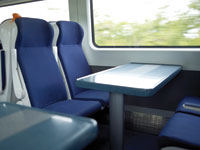
Posted to News on 19th Feb 2015, 00:00
Adhesives spread innovation across Europe's railways
Laurent Pourcheron of Huntsman Advanced Materials takes a look at the adhesive technologies which are enabling sustainable developments, helping manufacturers in the sector achieve competitive edge and secure long-term growth.

>Driven by rising road congestion, demand for mobility and concerns over climate change, in Europe consid-erable emphasis is now being placed on developing rail as a key transport mode by promoting step-change innovations for passenger rolling stock, freight transport and rail infrastructure.
>Rail is amongst the most efficient and climate-friendly forms of transport, yet currently it only carries approximately 10% of European cargo and 6% of passengers each year. The level of global competition is high and manufacturers need to focus on innovation leading to better services and reduced costs that offer an attractive choice for customers.
>The need to develop rail as a key mode of transportation is reflected in the establishment of the European Commission's 'Shift2Rail' initiative. This new public-private partnership has been set up to invest just under €1 billion in research and innovation to support better rail services and encourage more passengers and freight onto Europe's railways.
>Amongst the key areas identified for investment, the Shift2Rail initiative highlights production process improvements, new designs, weight savings, compliance to stringent safety and environmental standards and low maintenance costs as being vital to success. In this context, adhesives are playing an ever increasing role, providing well established solutions in addition to more advanced and innovative developments for all kinds of rail bonding applications.
>Adhesive bonding enables the most efficient methods of assembly. Whilst maximising long-term potential and performance, it also optimises manufacturing methods with easy handling and simplified assembly procedures which speed up cycle times and reduce costs in parts production.
>Adhesives form a continuous bond providing more uniform stress distribution within a leak proof solution which is also less prone to corrosion and therefore well placed to provide a longer service life under load on a wide range of applications.
>A bonded structure is often cited as a safer structure as the occurrence of fatigue cracks are reduced through the uniform distribution of stress concentration. Bond lines are also frequently described as crack formation stoppers.
>As there are no holes, rivets or fastening elements to weaken structures, adhesives also facilitate the integrity and strength of materials, giving a smooth appearance to designs with improved aesthetics on finished parts and greater design flexibility. For complex assemblies, such as composite sandwich structures, adhesives tend to be the only fastening technique that can successfully bond them together. They can also join dissimilar materials together and compensate for differences in the coefficients of thermal expansion, helping to lower ongoing maintenance costs.
>What's more, adhesive bonds can provide an electrically insulating barrier between surfaces and offer good dampening properties which are useful for reducing sound or vibrations. Extending the service life of parts, simplifying designs, streamlining assemblies and helping to produce lighter, safer structures, today's adhesives offer advanced properties which can deliver economic advantages at every level of the industry.
>There are structural adhesives for all segments of the rail market. Epoxy adhesives offer excellent adhesion to metals and thermoset composites, providing excellent durability, chemical and temperature resistance (up to 190°C) with low shrinkage. Polyurethanes are more suitable for bonding thermoplastics, offering good long-term durability, strength and flexibility
>Methacrylates offer good adhesion on metals, thermoset composites and most thermoplastics, providing both rigid and flexible mechanical properties and minimum surface preparation requirements. And phenolics are well suited to metals and friction materials. They offer outstanding temperature and chemical resistance and ease of application.
>For structural parts such as roofs, doors, floors and semi-structural products such as floor coverings, seat to floor attachments, door frames and hinges, epoxy adhesive offers the advantages of ease of application, high strength and shock resistance on multi-material assemblies. In Italy for example, epoxy adhesive is being used to bond a simple overlap joint aluminium seat fixture within a high-speed train, offering excellent dynamic load and fatigue resistance.
>Epoxy adhesive can also offer excellent chemical resistance and thermal stability even in temperatures ranging as high as 140°C, making it particularly beneficial for exterior applications on carriages where it helps to reduce structural weight whilst improving fatigue resistance on metal assemblies. This makes it a good choice to bond GRP driver cabins because it offers excellent adhesion, high durability in ambient weather conditions, fatigue resistance and toughness. It also enables greater design freedom, supporting the structural strength and integrity of the more complex and ergonomic shapes of driver cabins now seen on the latest generation of high-speed trains.
>In Germany, another epoxy adhesive is replacing the welding process used to assemble aluminium substrates on the driver compartments of regional train units. Adhesive bonding maximises process and performance benefits by minimising the steps in production, reducing costs and improving the design ergonomics whilst helping to extend the compartment's service life, thanks to its superior strength.
>Methacrylate adhesives tend to be used for bonding metal hinges to GRP interior panels and on a range of interior furnishings such as fold tables, luggage racks and ceiling liners, where their fast curing properties provide significant time saving advantages. In both Spain and Sweden, manufacturers are benefitting from this adhesive's rapid assembly and peel resistance on a range of rolling stock interior components, bonding doors to lockers, reinforcing train roofs and constructing WC modules.
>By contrast, the flexible properties of polyurethanes make them the adhesive of choice for joining tough-to-bond engineering thermoplastics, rigid plastics and composites, finding application in sandwich panel lamination and assembly for frames, wall cabinets, partition walls and panelling. In Spain for example, the combined flexibility, ease of application and colour of polyurethane adhesive have made it the ongoing adhesive of choice on a carriage floor joint bonding project.






